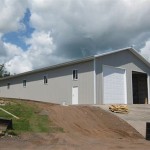Can I Turn My Garage Into a Bedroom? A Comprehensive Guide
The prospect of converting a garage into a functional bedroom is an enticing one for homeowners seeking additional living space. It can offer a relatively affordable solution compared to constructing a new addition. However, the transformation involves a complex interplay of building codes, structural considerations, and practical logistics. A thorough understanding of these elements is crucial before embarking on such a project.
Converting a garage into a bedroom is more than just adding some drywall and a bed. It involves ensuring the space is compliant with safety regulations, provides adequate insulation and ventilation, and integrates seamlessly with the existing home. Furthermore, the project can significantly impact the property's overall value and tax implications.
This article provides a comprehensive overview of the key considerations involved in converting a garage into a bedroom, providing essential information to help determine its feasibility and navigate the process successfully.
Key Point 1: Building Codes and Permits
One of the most crucial aspects of converting a garage into a bedroom is adhering to local building codes and obtaining the necessary permits. These regulations are in place to ensure the safety and structural integrity of the building, protecting its occupants from potential hazards. Ignoring these requirements can lead to costly fines, legal repercussions, and even the forced removal of the conversion.
The specific building codes vary depending on the municipality and often encompass aspects such as minimum room size, ceiling height, egress windows, fire safety measures, and electrical and plumbing standards. It is paramount to consult with the local building department to understand these requirements before initiating any construction work. Failure to comply can result in rejected permits, delayed project timelines, and potentially compromising the safety of the occupants.
A significant aspect of the permitting process involves submitting detailed plans outlining the proposed changes to the garage. These plans are typically reviewed by building inspectors to ensure compliance with all applicable codes. The plans should accurately depict the new layout, electrical wiring, plumbing, insulation, and ventilation systems. Engaging a qualified architect or structural engineer to create these plans can expedite the approval process and minimize potential issues during construction.
Egress is a critical safety concern addressed by building codes. Any bedroom must have at least two means of escape in case of a fire. Typically, this includes a door leading to the exterior and an egress window that meets specific size and operational requirements. The window must be large enough for an adult to crawl through and must be easily operable from the inside without the use of tools. Improper egress options can be a significant obstacle in obtaining permit approval.
Fire separation is another essential consideration. Building codes often require a fire-rated separation between the garage and the habitable portions of the house. This usually involves installing fire-resistant drywall on the garage walls and ceiling, as well as ensuring that any openings are properly sealed with fire-resistant materials. This measure is designed to slow the spread of a fire and provide occupants with more time to escape.
Electrical and plumbing work must be performed by licensed professionals and inspected to ensure compliance with electrical and plumbing codes. Improper wiring can lead to fire hazards, while faulty plumbing can result in leaks and water damage. It is crucial to use qualified contractors who are familiar with local codes and regulations to ensure a safe and compliant installation.
Furthermore, changes to the structure of the garage, such as adding windows or reinforcing the foundation, may require additional permits and inspections. It is important to consult with a structural engineer to determine if any structural modifications are necessary and to ensure that the building can withstand the added load.
Key Point 2: Structural and Environmental Considerations
Converting a garage into a bedroom requires careful consideration of the existing structure and the surrounding environment. Garages are often built with different structural standards than habitable spaces, and addressing these discrepancies is critical to ensuring a safe and comfortable living environment.
One of the primary concerns is the foundation. Garage floors are typically thinner than those designed for living spaces and may not have adequate insulation. Evaluating the existing floor for cracks, settling, or moisture problems is essential. Depending on the condition of the floor, it may be necessary to reinforce it or add a moisture barrier and insulation to prevent dampness and temperature fluctuations.
Insulation is crucial for maintaining a comfortable temperature and reducing energy costs. Garages are often poorly insulated, leading to significant heat loss in the winter and heat gain in the summer. Adding insulation to the walls, ceiling, and floor is essential for creating a habitable space. The type and amount of insulation required will depend on the climate and local building codes.
Ventilation is another critical factor. Garages are typically not designed with adequate ventilation, which can lead to stale air, moisture buildup, and potential mold growth. Installing a proper ventilation system, such as an exhaust fan or a fresh air intake, is crucial for maintaining air quality and preventing moisture problems.
Soundproofing may also be a concern, especially if the garage is located close to a busy street or other noise sources. Adding soundproofing materials to the walls and ceiling can help to reduce noise transmission and create a more peaceful living environment. This can include using dense insulation, resilient channels, and soundproof drywall.
The garage door opening presents a significant challenge in converting a garage into a bedroom. The opening must be properly framed and insulated to prevent drafts and moisture intrusion. One option is to completely remove the garage door and replace it with a framed wall. Another option is to insulate the existing garage door and add a weatherproof seal to prevent air leakage. The chosen method should be aesthetically pleasing and integrate seamlessly with the existing structure.
Moisture management is paramount. Garages are often susceptible to moisture intrusion from the ground, rain, and snow. Ensuring proper drainage around the garage and installing a vapor barrier can help to prevent moisture problems. Addressing any existing leaks or water damage is essential before commencing any construction work.
Furthermore, the garage may contain hazardous materials, such as asbestos, lead paint, or old chemicals. It is important to test for these materials and properly remediate them before starting any renovation work. Engaging a qualified environmental professional is crucial for identifying and addressing these potential hazards.
Key Point 3: Practical Considerations and Cost Estimation
Beyond the technical and regulatory aspects, converting a garage into a bedroom involves several practical considerations that can significantly impact the cost and timeline of the project. A realistic assessment of these factors is essential for making informed decisions and managing expectations.
The cost of converting a garage into a bedroom can vary widely depending on the size of the garage, the complexity of the design, and the materials used. A basic conversion can cost anywhere from $10,000 to $30,000, while a more elaborate project can easily exceed that range. It is important to obtain detailed quotes from multiple contractors to get an accurate estimate of the total cost. The estimate should include labor, materials, permits, and any unforeseen expenses.
The timeline for converting a garage into a bedroom can also vary depending on the scope of the project and the availability of contractors. A typical conversion can take anywhere from a few weeks to several months to complete. Delays can occur due to permit approvals, material shortages, or unexpected problems during construction. It is important to factor in a buffer for potential delays when planning the project.
The impact on parking should be considered. Converting a garage into a bedroom means sacrificing parking space. Consider what alternatives are available for parking vehicles, such as on-street parking or building a detached garage or carport. Local regulations may restrict on-street parking, so it is important to check with the local authorities.
The effect on property value should be evaluated. While adding a bedroom can potentially increase the value of the home, it is important to consider the overall market and the demand for bedrooms in the area. A poorly executed conversion can actually detract from the property value. Consulting with a real estate agent can provide insights into the potential impact on property value.
The integration with the existing home is important. The converted garage should seamlessly integrate with the existing home in terms of style, design, and functionality. This includes matching the exterior siding, roofing, and windows, as well as ensuring that the interior finishes are consistent with the rest of the house. A well-integrated conversion will enhance the overall appearance and value of the property.
Consider the long-term use of the space. Think about how the bedroom will be used and plan the design accordingly. Will it be used as a guest room, a home office, or a bedroom for a family member? The intended use will influence the layout, features, and amenities that are included in the design.
Finally, it is important to carefully vet contractors before hiring them. Check their licenses, insurance, and references. Read online reviews and ask for examples of their previous work. Choose a contractor who is experienced in garage conversions and who is willing to work with you to ensure that the project meets your expectations. A reputable contractor will be able to guide through the permitting process, provide accurate estimates, and complete the work on time and within budget.

51 Garage Conversion Ideas To Convert Your Living Space

Consider This Before You Convert Your Garage Into A Room Patio

6 Shocking Garage Conversion Before And After Photos Maxable

How To Convert Your Garage Into A Bedroom And Rent It Out Soho Real Estate

Garage Conversion 101 How To Turn A Into Living Space Youtube

Diy How To Turn A Garage Into Studio Apartment With Shiplap Metal

Converting Your Garage Into A Bedroom Home Gym Or Other Living Space Tips Ideas Step By Guide

Converting Our Garage Into Bedrooms Sidetracked Sarah

We Converted Our Garage Into A Bedroom

Garage Conversion Ideas To Improve Your Home








